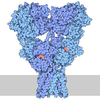[English] 日本語
 Yorodumi
Yorodumi- PDB-7te6: Crystal structure of GluN1b-2B ATD complexed to Fab5 anti-GluN2B ... -
+ Open data
Open data
- Basic information
Basic information
| Entry | Database: PDB / ID: 7te6 | |||||||||
|---|---|---|---|---|---|---|---|---|---|---|
| Title | Crystal structure of GluN1b-2B ATD complexed to Fab5 anti-GluN2B antibody | |||||||||
 Components Components |
| |||||||||
 Keywords Keywords | SIGNALING PROTEIN/IMMUNE SYSTEM / Fab fragment complexed to the receptor / SIGNALING PROTEIN-IMMUNE SYSTEM complex | |||||||||
| Function / homology |  Function and homology information Function and homology informationcellular response to curcumin / cellular response to corticosterone stimulus / cellular response to magnesium starvation / sensory organ development / sensitization / EPHB-mediated forward signaling / Assembly and cell surface presentation of NMDA receptors / response to hydrogen sulfide / auditory behavior / dendritic branch ...cellular response to curcumin / cellular response to corticosterone stimulus / cellular response to magnesium starvation / sensory organ development / sensitization / EPHB-mediated forward signaling / Assembly and cell surface presentation of NMDA receptors / response to hydrogen sulfide / auditory behavior / dendritic branch / response to other organism / regulation of ARF protein signal transduction / fear response / apical dendrite / positive regulation of inhibitory postsynaptic potential / suckling behavior / response to methylmercury / response to manganese ion / response to carbohydrate / interleukin-1 receptor binding / cellular response to dsRNA / response to growth hormone / cellular response to lipid / negative regulation of dendritic spine maintenance / heterocyclic compound binding / positive regulation of glutamate secretion / regulation of monoatomic cation transmembrane transport / RAF/MAP kinase cascade / NMDA glutamate receptor activity / Synaptic adhesion-like molecules / response to glycoside / NMDA selective glutamate receptor complex / glutamate binding / ligand-gated sodium channel activity / response to zinc ion / calcium ion transmembrane import into cytosol / protein heterotetramerization / glycine binding / response to amine / regulation of cAMP/PKA signal transduction / small molecule binding / receptor clustering / parallel fiber to Purkinje cell synapse / startle response / monoatomic cation transmembrane transport / behavioral response to pain / regulation of MAPK cascade / regulation of postsynaptic membrane potential / associative learning / response to magnesium ion / action potential / extracellularly glutamate-gated ion channel activity / response to electrical stimulus / monoatomic cation transport / regulation of neuronal synaptic plasticity / glutamate receptor binding / Unblocking of NMDA receptors, glutamate binding and activation / positive regulation of excitatory postsynaptic potential / long-term memory / detection of mechanical stimulus involved in sensory perception of pain / response to mechanical stimulus / synaptic cleft / neuron development / multicellular organismal response to stress / positive regulation of synaptic transmission, glutamatergic / behavioral fear response / postsynaptic density, intracellular component / monoatomic cation channel activity / response to fungicide / glutamate-gated receptor activity / cell adhesion molecule binding / regulation of long-term synaptic depression / D2 dopamine receptor binding / cellular response to manganese ion / glutamate-gated calcium ion channel activity / presynaptic active zone membrane / response to cytokine / ionotropic glutamate receptor binding / ligand-gated monoatomic ion channel activity involved in regulation of presynaptic membrane potential / ionotropic glutamate receptor signaling pathway / cellular response to forskolin / sodium ion transmembrane transport / protein tyrosine kinase binding / synaptic membrane / response to amphetamine / hippocampal mossy fiber to CA3 synapse / learning / response to nicotine / regulation of membrane potential / response to cocaine / excitatory postsynaptic potential / transmitter-gated monoatomic ion channel activity involved in regulation of postsynaptic membrane potential / synaptic transmission, glutamatergic / hippocampus development / cellular response to amino acid stimulus / regulation of long-term neuronal synaptic plasticity / postsynaptic density membrane / response to calcium ion / beta-catenin binding / cerebral cortex development Similarity search - Function | |||||||||
| Biological species |   | |||||||||
| Method |  X-RAY DIFFRACTION / X-RAY DIFFRACTION /  SYNCHROTRON / SYNCHROTRON /  MOLECULAR REPLACEMENT / Resolution: 4.55 Å MOLECULAR REPLACEMENT / Resolution: 4.55 Å | |||||||||
 Authors Authors | Regan, M. / Tajima, N. / Furukawa, H. | |||||||||
| Funding support |  United States, 2items United States, 2items
| |||||||||
 Citation Citation |  Journal: Nat Commun / Year: 2022 Journal: Nat Commun / Year: 2022Title: Development and characterization of functional antibodies targeting NMDA receptors. Authors: Nami Tajima / Noriko Simorowski / Remy A Yovanno / Michael C Regan / Kevin Michalski / Ricardo Gómez / Albert Y Lau / Hiro Furukawa /  Abstract: N-methyl-D-aspartate receptors (NMDARs) are critically involved in basic brain functions and neurodegeneration as well as tumor invasiveness. Targeting specific subtypes of NMDARs with distinct ...N-methyl-D-aspartate receptors (NMDARs) are critically involved in basic brain functions and neurodegeneration as well as tumor invasiveness. Targeting specific subtypes of NMDARs with distinct activities has been considered an effective therapeutic strategy for neurological disorders and diseases. However, complete elimination of off-target effects of small chemical compounds has been challenging and thus, there is a need to explore alternative strategies for targeting NMDAR subtypes. Here we report identification of a functional antibody that specifically targets the GluN1-GluN2B NMDAR subtype and allosterically down-regulates ion channel activity as assessed by electrophysiology. Through biochemical analysis, x-ray crystallography, single-particle electron cryomicroscopy, and molecular dynamics simulations, we show that this inhibitory antibody recognizes the amino terminal domain of the GluN2B subunit and increases the population of the non-active conformational state. The current study demonstrates that antibodies may serve as specific reagents to regulate NMDAR functions for basic research and therapeutic objectives. | |||||||||
| History |
|
- Structure visualization
Structure visualization
| Structure viewer | Molecule:  Molmil Molmil Jmol/JSmol Jmol/JSmol |
|---|
- Downloads & links
Downloads & links
- Download
Download
| PDBx/mmCIF format |  7te6.cif.gz 7te6.cif.gz | 405.9 KB | Display |  PDBx/mmCIF format PDBx/mmCIF format |
|---|---|---|---|---|
| PDB format |  pdb7te6.ent.gz pdb7te6.ent.gz | 327.3 KB | Display |  PDB format PDB format |
| PDBx/mmJSON format |  7te6.json.gz 7te6.json.gz | Tree view |  PDBx/mmJSON format PDBx/mmJSON format | |
| Others |  Other downloads Other downloads |
-Validation report
| Summary document |  7te6_validation.pdf.gz 7te6_validation.pdf.gz | 493 KB | Display |  wwPDB validaton report wwPDB validaton report |
|---|---|---|---|---|
| Full document |  7te6_full_validation.pdf.gz 7te6_full_validation.pdf.gz | 533.4 KB | Display | |
| Data in XML |  7te6_validation.xml.gz 7te6_validation.xml.gz | 77.9 KB | Display | |
| Data in CIF |  7te6_validation.cif.gz 7te6_validation.cif.gz | 104.4 KB | Display | |
| Arichive directory |  https://data.pdbj.org/pub/pdb/validation_reports/te/7te6 https://data.pdbj.org/pub/pdb/validation_reports/te/7te6 ftp://data.pdbj.org/pub/pdb/validation_reports/te/7te6 ftp://data.pdbj.org/pub/pdb/validation_reports/te/7te6 | HTTPS FTP |
-Related structure data
| Related structure data |  7te4C 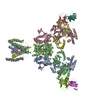 7te9C 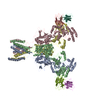 7tebC  7teeC 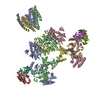 7teqC 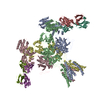 7terC 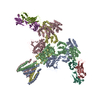 7tesC 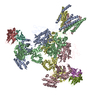 7tetC 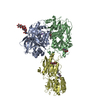 3qelS  5b3jS S: Starting model for refinement C: citing same article ( |
|---|---|
| Similar structure data |
- Links
Links
- Assembly
Assembly
| Deposited unit | 
| ||||||||
|---|---|---|---|---|---|---|---|---|---|
| 1 | 
| ||||||||
| 2 | 
| ||||||||
| Unit cell |
|
- Components
Components
| #1: Protein | Mass: 42932.055 Da / Num. of mol.: 2 Source method: isolated from a genetically manipulated source Source: (gene. exp.)  #2: Protein | Mass: 41367.902 Da / Num. of mol.: 2 Source method: isolated from a genetically manipulated source Source: (gene. exp.)   #3: Antibody | Mass: 23844.684 Da / Num. of mol.: 2 / Source method: isolated from a natural source / Source: (natural)  #4: Antibody | Mass: 23855.256 Da / Num. of mol.: 2 / Source method: isolated from a natural source / Source: (natural)  |
|---|
-Experimental details
-Experiment
| Experiment | Method:  X-RAY DIFFRACTION / Number of used crystals: 1 X-RAY DIFFRACTION / Number of used crystals: 1 |
|---|
- Sample preparation
Sample preparation
| Crystal | Density Matthews: 3.01 Å3/Da / Density % sol: 59.11 % |
|---|---|
| Crystal grow | Temperature: 290 K / Method: vapor diffusion, hanging drop Details: 2.1 M sodium/potassium phosphate, 100 mM lithium sulfate, 100 mM CAPS, pH 10.5, 4% formamide |
-Data collection
| Diffraction | Mean temperature: 100 K / Serial crystal experiment: N |
|---|---|
| Diffraction source | Source:  SYNCHROTRON / Site: SYNCHROTRON / Site:  APS APS  / Beamline: 23-ID-B / Wavelength: 1.1 Å / Beamline: 23-ID-B / Wavelength: 1.1 Å |
| Detector | Type: DECTRIS PILATUS3 6M / Detector: PIXEL / Date: Oct 10, 2018 |
| Radiation | Protocol: SINGLE WAVELENGTH / Monochromatic (M) / Laue (L): M / Scattering type: x-ray |
| Radiation wavelength | Wavelength: 1.1 Å / Relative weight: 1 |
| Reflection | Resolution: 4.54→30 Å / Num. obs: 17965 / % possible obs: 97.5 % / Redundancy: 7.7 % / Rmerge(I) obs: 0.156 / Net I/σ(I): 6.2 |
| Reflection shell | Resolution: 4.54→4.66 Å / Num. unique obs: 1644 / CC1/2: 0.534 |
- Processing
Processing
| Software |
| ||||||||||||||||||||||||||||||||||||||||||||||||
|---|---|---|---|---|---|---|---|---|---|---|---|---|---|---|---|---|---|---|---|---|---|---|---|---|---|---|---|---|---|---|---|---|---|---|---|---|---|---|---|---|---|---|---|---|---|---|---|---|---|
| Refinement | Method to determine structure:  MOLECULAR REPLACEMENT MOLECULAR REPLACEMENTStarting model: PDB entries 5B3J & 3QEL Resolution: 4.55→24.984 Å / SU ML: 0.77 / Cross valid method: THROUGHOUT / σ(F): 1.36 / Phase error: 33.7 / Stereochemistry target values: ML
| ||||||||||||||||||||||||||||||||||||||||||||||||
| Solvent computation | Shrinkage radii: 0.9 Å / VDW probe radii: 1.11 Å / Solvent model: FLAT BULK SOLVENT MODEL | ||||||||||||||||||||||||||||||||||||||||||||||||
| Displacement parameters | Biso max: 222.11 Å2 / Biso mean: 83.7583 Å2 / Biso min: 38.55 Å2 | ||||||||||||||||||||||||||||||||||||||||||||||||
| Refinement step | Cycle: final / Resolution: 4.55→24.984 Å
| ||||||||||||||||||||||||||||||||||||||||||||||||
| LS refinement shell | Refine-ID: X-RAY DIFFRACTION / Rfactor Rfree error: 0
|
 Movie
Movie Controller
Controller










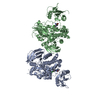
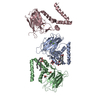
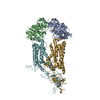


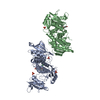
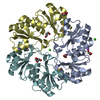
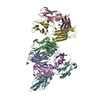
 PDBj
PDBj